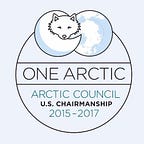WEEK 42: MARYLAND
Whimsical Arctic Art from a Maryland Illustrator
By David Scheirer, watercolor painter and illustrator in Woodbine, Maryland.
As a lifelong Marylander I am intrigued by the connections between my home state and the Arctic. Maryland’s most obvious connection to the Arctic is migratory birds. I enjoy birdwatching and especially appreciate the Arctic residents that visit our state at certain times of the year. Various sandpipers, plovers and turnstones that nest in the Arctic can be seen along Maryland’s coasts and waterways as they migrate in the spring and autumn.
When I was young, my dad occasionally traveled for the government. On one such trip he visited Thule Air Base. Located 750 miles north of the Arctic circle in Greenland, it is the United States’ northernmost Air Force base. Dad returned with stories of flying in ski planes and seeing Arctic wildlife, including his favorite, the Arctic Fox. His stories and pictures spurred my own interest in the Arctic, which is now a favorite subject for me when drawing. The iconic animals, harsh weather, open grassy tundra, and icy barren landscapes are all interesting subjects that suit my minimal style.
My illustrations are drawn in a graphic, simplified manner and are created with ink and watercolors. I especially enjoy drawing animals and the habitats they live in. I try to find a balance between simplicity and reality in these drawings and I enjoy finding ways to capture the essence of an animal with a few simple lines.
Oceans were the first environment I drew as I developed this style. As my interest in the Arctic grew, its waters and marine mammals were among the first Arctic subjects I illustrated.
In addition to the playful illustrations shown here, I also create realistic watercolor paintings, often of subjects close to home: birds, animals, fossils, and plants from Maryland and the East Coast. My whimsical illustrations offer an interesting contrast to that work, although they are rooted in reality and science as well. They allow me to create from my imagination. I have fun drawing environments from across the globe that maybe I have yet to visit.
Many of my Snowy Owl illustrations depict them wintering in more southern habitats, such as along this coastline. Snowy Owls like beaches, farm fields, airports and other open areas that mimic the tundra. The past few years, lucky Maryland and Washington, D. C., residents were able to see Snowy Owls that wintered farther south than usual.
Tundra Swans also come to spend their winter on the Chesapeake Bay and its tributaries. I discovered this for myself while hiking along the Potomac River in Southern Maryland, at a point where the river is wide and slow moving. As I came within earshot of the river I heard a strange droning. I was very confused until I came out of the trees and realized that the noise came from the honking of many hundreds of brilliant white Tundra Swans. The Algonquian Native Americans had names for different parts of the Potomac River, and there is good reason that this southern section was called Patawomke which means river of swans.
Above is an illustration of a Long-tailed Weasel on the Arctic Tundra. This diminutive little hunter has been my favorite animal since I was in third grade! In its northern range these weasels turn white in the winter, just like the Arctic Fox and Snowshoe Hare.
The Northern Lights are another of my favorite subjects. I love seeing how other artists interpret them! For me, they are a challenge and I enjoy experimenting and painting them in new ways.
My illustrations are well suited for children, but I’ve found they are enjoyed by people of all ages who love animals, and in particular (somewhat surprisingly to me) people who study animals. Over the years I’ve had the pleasure of fulfilling commissions for biologists, interns, and others who devote their time to learning, teaching and conserving wildlife and wild spaces.
Below is a commissioned piece, done for a professor who has a research center on an island in the Canadian Arctic. He and his students studied Snow Buntings and how they deal with environmental conditions. The illustration is based on a story he told about a Short-eared Owl that perched atop one of the Snow Bunting traps. The traps are used to capture the birds for banding but also served as an unintentional lure for the owl that was attracted by the little birds inside.
Out of my entire collection of illustrations, my Arctic artwork sells particularly well. It is bought by people all over the United States and even worldwide who appreciate my minimalist style but also what it represents. We are an Arctic nation at heart, being a people who are inspired by the freedom inherent in the expansive polar environment as well as the challenge of life in such rigorous, often dangerous, conditions. We feel connected to the Arctic in many ways, especially through story, history, and art. My Arctic artwork expresses my own connection to this fascinating and beautiful part of our planet.
About the Author: David Scheirer is a dad (to one boy and two cats), an Eagle Scout, a full time artist, and a part time birdwatcher, fossil collector, and beachcomber. He grew up in Kensington, Maryland, and graduated with a degree in painting from the Maryland Institute College of Art in Baltimore. He currently lives on a small farm 40 miles north of Washington, D. C., and is inspired by the serenity of horse pastures and farm fields outside his studio windows. David works as an independent painter and illustrator. During his career he’s had the pleasure of collaborating with various wildlife organizations including Audubon’s Project Puffin in Maine and International Bird Rescue.
See more of his artwork on his websites: www.studiotuesday.com and www.dswatercolors.com
